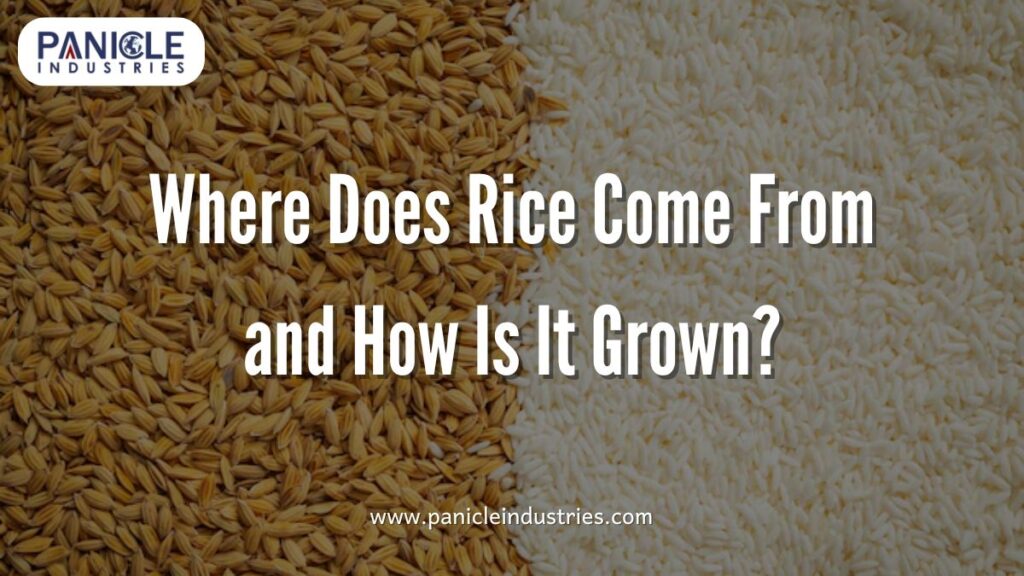Rice is one of the most important foods in the world, feeding billions of people every day. But many people often wonder, where does rice come from and how is it grown? The answer takes us on a journey from the paddy fields to our dining tables. Rice has a long history, and it is grown in many countries, especially in Asia, where it is a daily staple. Growing rice is a unique process that requires the right climate, soil, and water management. Unlike other crops, rice thrives in flooded fields and follows several stages before it is ready for harvest.
In this blog, we will explore the origins of rice, its cultivation process, and why it is such an essential crop worldwide.
The Origin of Rice
Rice has been cultivated for thousands of years. It is believed to have originated in China around 10,000 years ago before spreading to other parts of Asia, Africa, and the world. Over time, rice became a cultural and dietary staple for millions of people. Today, countries like India, China, Indonesia, and Vietnam are among the largest producers of rice. Its long history shows how deeply connected rice is with human survival and traditions.
Also read: How Should Dry Rice Be Stored in a Dry Storage Area
Where Does Rice Come From?
Rice comes from paddy fields, which are specially prepared pieces of land that are either naturally or artificially flooded with water. These fields provide the perfect environment for rice plants to grow. Unlike wheat or corn, rice plants thrive in wet conditions because they can survive in standing water. Most rice is grown in tropical and subtropical regions where the weather is warm and the rainfall is sufficient.
Understanding the Types of Rice
There are many varieties of rice grown across the world. The most common types are:
- White Rice: Popular worldwide, polished and soft in texture.
- Brown Rice: Whole-grain rice with more fiber and nutrients.
- Basmati Rice: Aromatic long-grain rice mainly grown in India and Pakistan.
- Jasmine Rice: Fragrant rice commonly grown in Thailand.
- Sticky Rice: Mostly grown in East Asia, used in traditional dishes.
Each variety has unique characteristics, but the growing process is mostly similar.
How Is Rice Grown? Step-by-Step Process
1. Selecting the Land
The first step is choosing fertile land with access to water. Rice needs flat fields that can hold water for long periods. Soil rich in nutrients is best for rice cultivation.
2. Preparing the Field
Farmers plow the fields to soften the soil. The land is then leveled to make sure water spreads evenly. In many regions, fields are flooded with water before planting to create the perfect environment.
3. Planting the Seeds
There are two main methods of planting rice:
- Direct Seeding: Seeds are sown directly into the field.
- Transplanting: Seeds are first grown in nurseries and then small seedlings are transplanted into flooded fields.
Transplanting is a common practice in Asia because it gives better yields.
4. Growing Stage
Once planted, rice plants need plenty of water and sunlight. The fields are kept flooded for most of the growing season. Farmers carefully manage the water level and protect the plants from pests and weeds.
5. Flowering and Grain Formation
After a few weeks, the rice plants start flowering, and small grains begin to form. This stage is very sensitive, and the plants need careful care to ensure healthy grain development.
6. Harvesting
When the rice plants turn golden yellow and the grains harden, it is time for harvest. Farmers either cut the plants manually or use machines. The harvested rice is then dried in the sun before processing.
Water – The Key to Rice Cultivation
Water plays the most important role in rice farming. Rice fields, also called paddies, are kept flooded because water helps control weeds, provides the right temperature, and protects the plants. While rice needs a lot of water, modern farming techniques like System of Rice Intensification (SRI) are being used to save water and grow rice more sustainably.
Countries That Produce the Most Rice
Rice is grown in more than 100 countries, but some countries dominate its production:
- China: The world’s largest rice producer.
- India: The second largest producer, famous for basmati rice.
- Indonesia, Vietnam, Thailand: Major exporters of rice.
- United States: Known for high-quality long-grain rice.
These countries not only grow rice for themselves but also export it worldwide.
Importance of Rice in Daily Life
Rice is more than just food; it is a way of life. For billions of people in Asia, Africa, and Latin America, rice is eaten daily in different forms—boiled, steamed, fried, or made into desserts. It provides energy, fills the stomach, and is affordable for both poor and rich households. In many cultures, rice is also part of rituals, festivals, and traditions.
Nutritional Value of Rice
Rice is an excellent source of carbohydrates, which provide energy. Brown rice also contains fiber, vitamins, and minerals like magnesium and phosphorus. While white rice is lighter and easier to digest, brown rice is healthier because it is less processed. Both types are important in different diets.
Challenges in Rice Farming
While rice is vital, its farming faces many challenges:
- Water Shortage: Rice requires a lot of water, which can be a problem in drought-prone areas.
- Climate Change: Floods, droughts, and changing weather affect rice production.
- Pests and Diseases: Insects and plant diseases reduce crop yields.
- Labor-Intensive Work: Rice farming requires a lot of effort, especially in countries where machines are not widely used.
Modern technology and sustainable farming practices are helping overcome these challenges.
Future of Rice Cultivation
With the growing global population, rice demand will continue to rise. Scientists are working on developing high-yield and drought-resistant rice varieties. Sustainable methods like drip irrigation, organic farming, and efficient machinery will also play an important role in ensuring rice production continues for future generations.
Conclusion
So, where does rice come from and how is it grown? Rice comes from paddy fields that are carefully prepared, planted, and managed until the golden grains are ready for harvest. The process involves multiple stages—preparing the land, planting seeds, nurturing plants, and finally harvesting. Rice is not just a crop but a lifeline for billions of people across the world. It provides energy, nutrition, and cultural value to many societies. Though rice farming faces challenges, new techniques and sustainable practices are ensuring a brighter future. Understanding where rice comes from helps us appreciate the effort that goes into every grain on our plate.


